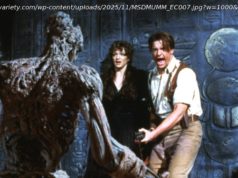 Though there were no film acting roles on George Michael’s CV, the late singer could still claim to have worked with Lindsay Anderson , the legendary Free Cinema pioneer and director of the influential and incendiary 1968 film If… (not to mention former film critic of this parish).
Though there were no film acting roles on George Michael’s CV, the late singer could still claim to have worked with Lindsay Anderson , the legendary Free Cinema pioneer and director of the influential and incendiary 1968 film If… (not to mention former film critic of this parish).
Both men’s obituary writers tended to overlook this unlikely collaboration but then that’s scarcely surprising given that it never really saw the light of day – at least not in the form that Anderson intended.
He was at an odd stage of his career in the early 1980s. He had been on both sides of the critical divide, having made a rare acting appearance in 1981 in the widely-adored, Oscar-winning Chariots of Fire before then facing critical opprobrium and public indifference in 1982 for his savage state-of-the-nation satire Britannia Hospital , which used the ailing institution of the title as a metaphor for the country.
He turned down another acting role, as the Emperor in Return of the Jedi , and was having his usual difficulty getting a movie off the ground when he was offered the chance to return to his documentary roots by shooting a film about the first western pop group to play in China. That group was Wham!
Anderson, who was then almost 62-years-old, was reluctant at first, as he so often was. “Have I the energy? The curiosity? The conviction?” he wrote in his diary after being offered the job in March 1985. “How on earth have two (lower) middle class boys from Watford managed to transform themselves into these vibrant figures of pop myth…? It’s a complete mystery.”
Still, he pressed on, and had lunch with George Michael and Andrew Ridgeley. “I have really nothing to say to them: confident, bright, uninteresting, respectable, of the Eighties . .. I get the impression they will be reasonably cooperative. Certainly not inspiring.”
The trip was not, all things considered, a huge success. Anderson suffered some medical setbacks. He had rheumatism so severe that he had to use the fingers on his left hand to prise open the ones on his right. Then he tore a ligament while shooting at the Great Wall of China.
He learned that Michael didn’t like being photographed and so the film became more of a portrait of the Chinese people and the gentle culture clash that occurred with Wham! in their midst.
In 1986, Anderson admitted that he had accepted the commission “in a spirit of curiosity. Curiosity about China and curiosity about the odd confrontation of China and Wham! – and even a certain curiosity, not very great, about the phenomenon of Wham! itself.”
But during shooting it dawned on him that he was “not engaged to direct a film of Wham! in China – I was engaged to occupy the position of director .”
A rough cut, titled If You Were There , was viewed by the band’s managers, Simon Napier-Bell and Jazz Summers, in October 1985. Though it was incomplete, suggestions and criticisms were put to Anderson, who responded by writing personally to Michael:
“[Y]ou know that when people who don’t really understand the creative process – whether it is film or music – start formulating criticisms and making demands on a work in progress, it is only too easy for the whole enterprise to founder. .. Jazz and Simon both seem terrified of you – which may be useful sometimes but at other times can be dangerous. I certainly have enough respect for your creative verve and intelligence not to be scared to show you the work, and of course, to be interested in your feelings about it.”
Michael never replied to the letter (though he did see Wham! in China! , as it was now called, at a screening which Anderson said “went extremely well”). The director heard in November that the film was being taken off him and recut.
The finished film moved Wham! to the forefront and China to the background. In the course of researching a Radio 4 documentary about Anderson in 2008, the journalist John Harris saw Anderson’s cut and called it , “a rich, poetic, panoramic portrait of China’s strangeness to the eyes of outsiders…”
Its defining flaw, according to Michael, was that it hadn’t felt “modern” enough.
Anderson died in 1994. His archive is at the University of Stirling and letters held there reveal his fury at the butchering of his film. He called Michael, “a shivering aspirant plucked out of the street, who turns almost overnight into a tyrant of fabulous wealth, whose every command his minions must dash to execute” and “a young millionaire with an inflated ego. . [whose] vision only extends to the top 10 . .. It’ll be interesting to see if there’s any limit to his reckless autocracy.”
Michael apparently blocked a proposed screening at Stirling of Anderson’s version. Andy Stephens, the singer’s then-manager called it “a dreadful film”. But Anderson told his diary: “I do think that between them the Whammies have destroyed, or suppressed, an enjoyable, informative, entertaining and at times even beautiful film.”
The original cut is available to view privately at Stirling. Whether Michael’s death means that it will now be made more widely available (as with, say, Stanley Kubrick and A Clockwork Orange ) is another matter. For now it will have to carry on being the answer to a pub quiz question as well as a jigsaw piece, out-of-reach if not exactly missing, for completists of singer and filmmaker alike.
One of the clichés about celebrity life is that all celebrities know each other. Back in the Eighties, when we were moderately famous, Ben and I did often bump into other famous people, and because of mutual recognition, there was a sort of acquaintance, if not friendship.
There was a random element to it, as well. Some celebrities you might never catch a glimpse of, while others seemed to pop up with an unexpected regularity.
In 1987, the car we drove was a 1970s Austin Princess, all leather seats and walnut dashboard. In many ways, it symbolised what people thought of as the basic qualities of our band: unassuming, a little bit quirky, a little bit vintage. We’d had it for a year or so, but Ben was running out of patience. It had a habit of letting us down at inconvenient moments – for instance, at the top of the long, steep climbs that you encounter when driving through Italy, which we had just recklessly done for a holiday. The car was such a novelty out there that it attracted crowds whenever we parked. They would gather round, nodding appreciatively, stroking the bonnet and murmuring, “ Bella macchina. . .”
Having recently banked a couple of royalty cheques, Ben was thinking of a complete change of style – a rock’n’roll, grand-gesture kind of car.
“I wanna get an old Mercedes 300 SL,” he said to me.
“What’s one of those?”
“I’ll let you know next time we pass one,” he said.
We were driving through London in the Princess, and as we swung round into Sloane Square, Ben called out, “There’s one, look, coming up on the inside now!” I looked round at this vision of gleaming steel and chrome, gliding along effortlessly beside us, and at the same moment the driver glanced over towards our funny little car.
Start
United States
USA — Cinema Why was this film about George Michael never released? We knew we’d...






